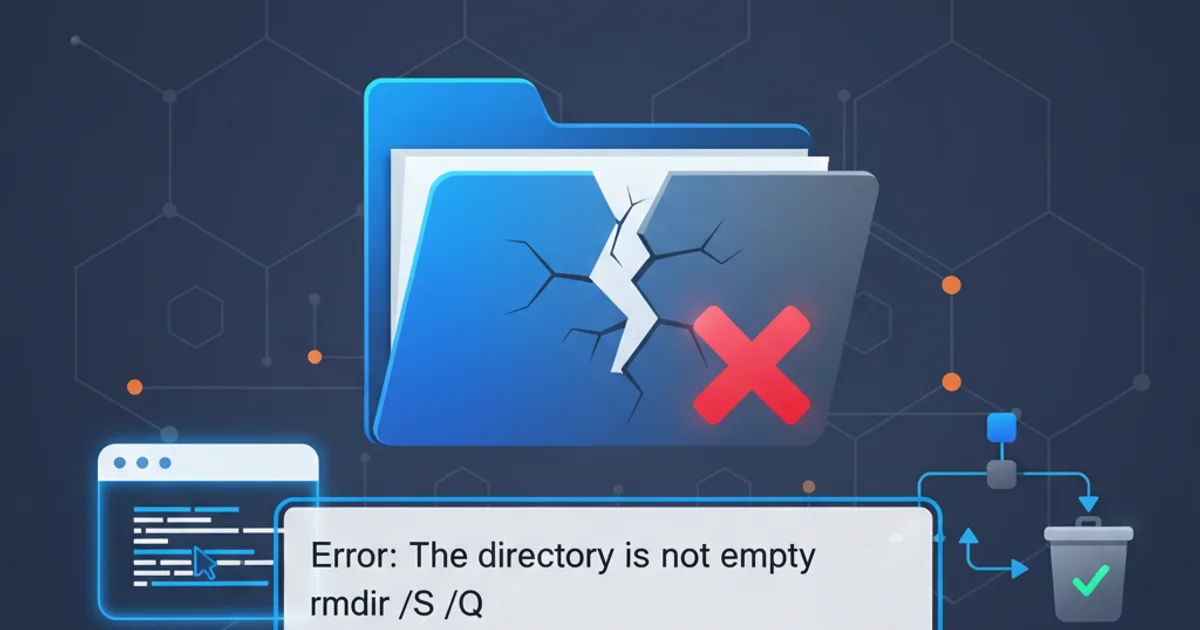How to solve "The directory is not empty" error when running rmdir command in a batch script?
Categories:
Resolving 'The directory is not empty' Error with RMDIR in Batch Scripts

Learn how to effectively handle and prevent the 'The directory is not empty' error when using the RMDIR command in Windows batch scripts, ensuring robust directory deletion.
When working with batch scripts in Windows, you often need to delete directories. The RMDIR (or RD) command is the standard tool for this. However, a common pitfall is encountering the error message "The directory is not empty" even when you believe the directory should be empty. This article will explain why this error occurs and provide robust solutions to ensure your batch scripts can reliably delete directories, whether they contain files or not.
Understanding the 'Directory Not Empty' Error
The RMDIR command, by default, is designed to only remove empty directories. If the target directory contains any files or subdirectories, even hidden ones, RMDIR will fail with the "The directory is not empty" error. This is a safety mechanism to prevent accidental data loss. While useful, it can be frustrating when you intend to delete a directory and all its contents.
flowchart TD
A[Start RMDIR Command] --> B{Is Directory Empty?}
B -->|Yes| C[Delete Directory]
C --> D[Success]
B -->|No| E["Error: 'The directory is not empty'"]
E --> F[Failure]Default RMDIR behavior flowchart
Solution 1: Using the /S and /Q Switches
The most common and effective way to force RMDIR to delete a directory and all its contents, regardless of whether it's empty, is to use the /S (subdirectories and files) and /Q (quiet mode, no prompt) switches. The /S switch tells RMDIR to remove all directories and files in the specified directory in addition to the directory itself. The /Q switch suppresses the confirmation prompt, making it suitable for automated scripts.
RMDIR /S /Q "C:\Path\To\Your\Directory"
Using RMDIR with /S and /Q switches
RMDIR /S /Q. This command will permanently delete all files and subdirectories within the specified path without any confirmation. Double-check your path to avoid accidental data loss.Solution 2: Handling Locked Files or Permissions Issues
Even with /S /Q, RMDIR can still fail if files within the directory are in use (locked by another process) or if the script lacks the necessary permissions. In such cases, you might need to take additional steps:
- Check for Locked Files: Identify and close any applications or processes that might be holding files open in the target directory.
- Run as Administrator: Ensure your batch script is executed with administrative privileges, especially if you're trying to delete directories in system-protected areas.
- Delay and Retry: For transient locking issues, a short delay and a retry mechanism can sometimes resolve the problem.
- Alternative Tools: For persistent issues with locked files, consider using third-party tools like
DELPROF(from Windows Server 2003 Resource Kit) orhandle.exe(from Sysinternals) to identify and potentially close file handles, though this is generally more complex for simple batch scripts.
@echo off
SET "TARGET_DIR=C:\Path\To\Your\Directory"
:TRY_DELETE
RMDIR /S /Q "%TARGET_DIR%"
IF EXIST "%TARGET_DIR%" (
ECHO Directory "%TARGET_DIR%" could not be deleted. Retrying in 5 seconds...
TIMEOUT /T 5 /NOBREAK >NUL
GOTO TRY_DELETE
) ELSE (
ECHO Directory "%TARGET_DIR%" deleted successfully.
)
Batch script with retry logic for directory deletion
IF EXIST or IF NOT ERRORLEVEL 0) after the RMDIR command to verify success and handle failures gracefully.